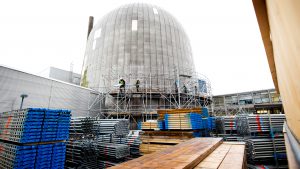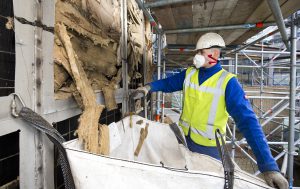New covering dome RID
The aluminium sheets on the outside of the Delft Reactor Institute reached the end of their technical service life in 2019. Therefore, they have been replaced.
There were several technical challenges involved in replacing the aluminium plates. First of all, the safe assembly of a scaffold. The perimeter of the building is round and the top is sloping. Building the scaffolding was specialised work, which took several weeks. In addition, the scaffolding was stabilised in a different way than usual. Normally, the supporting construction is anchored to the façade. This was not possible, because the facade panels were being renewed. Huge water reservoirs provided the necessary weight to keep the scaffolding in place under all weather conditions and other forms of stress.
Asbestos and insulation
The original construction dates back to 1963. A preliminary structural survey had revealed that sealant containing asbestos had been used under the plates. The insulation material also needed to be replaced. The sheets were cut loose piece by piece using a technique similar to a can opener, so that most of the metal was already removed. Next, all materials containing asbestos were safely removed and disposed of. After replacing the insulation, the construction could be built up layer by layer: first, the framework was attached. This is a steel frame between the base construction and the outer layer, in order to attach the metal sheets to.
Meticulous
Attaching the new metal plates had to be done with extreme precision. At the top of the dome, each ‘pie slice’ was placed in the right place, after which the lower layers followed. During this work it became apparent that the slightest deviation could have a major effect a few metres further down. The base of the dome, to which the battens are attached and on which the sheets rest, is not perfectly round and even. This presented great challenges to the contractor, who managed to apply a tight sheeting with neat and creative solutions. During preparations, the users were involved in chosing the material: they were given a choice of different shades of grey. The insulation material also needed to be replaced. The sheets were cut loose piece by piece using a technique similar to a can opener, so that most of the metal was already removed. Next, all materials containing asbestos were safely removed and disposed of. After replacing the insulation, the construction could start again layer by layer: first, the framework was attached. This is a steel frame between the substrate and the outer layer: the metal sheets were attached to the frame.
Planning
- Start: Q4 2019
- Implementation: 2020-2021
- Delivery: Q2 2021
Facts and figures
- The erection of the scaffolding took 6 weeks and the dismantling 4 weeks.
- 200 aluminium sheets were replaced.
- The total surface area is 2,100 m2. This includes the construction of the frame, the insulation and the sheets.
- The frame under the sheets was fastened with 5,000 washers, nuts and screws.
- The aluminium sheets were fastened with 7,000 pop rivets.










